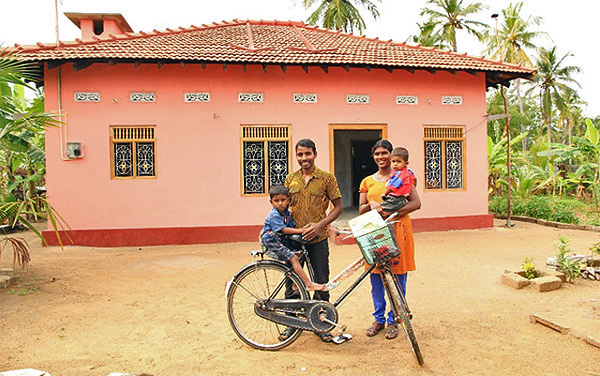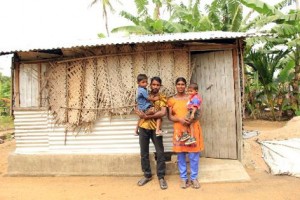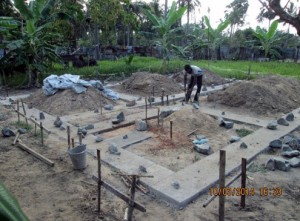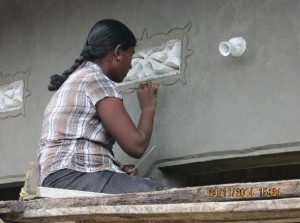Stories from the Field: A permanent Home for a Young Family in Mullaitivu

Thajeekaran family outside their permanent home.
The Indian Housing Project (IHP) is a housing reconstruction project funded by the Government of India and implemented through a Memorandum of Understanding with the Government of Sri Lanka. UN-Habitat is implementing this project in the Northern districts of Killinochchi, Mullaitivu and Jaffna. Through a homeowner driven process, UN-Habitat will support 18,000 families to construct permanent homes from 2012 to 2015.
Mr. S. Thajeekaran and his wife Lingeshwary from Mullaitivu District constructed their house with a grant from the project. Following many years of displacement and hardship living in IDP camps and temporary shelters, this young family is now enjoying their brand new home. This new home is particularly special to the homeowners as they have contributed their own labour towards its construction, providing both masonry and carpentry work.
35 year old Thajeekaran hails from Sivanagar village in Puthukudiriyippu Divisional Secretariat in Mullaitivu. He and his wife Lingeshwary have three sons aged eight, four and two years. Their eldest son attends Anandapuram Government Tamil Mixed School while the second son is a pre-schooler. The couple, like thousands of others in the North, were badly affected by the conflict and faced many challenges. In 2008, Thajeekaran made the difficult decision to move to Kalimodai Internally Displaced Persons camp in Mannar to avoid forced recruitment by the LTTE.

The temporary shelter where the family lived for over two years.
While Thajeekaran was away, Lingeshwary and their eldest son faced many difficulties. In 2009, during the last stages of the conflict, the mother and son had to leave their village. Lingeshwary finally managed to move to the Jaffna peninsula where she found shelter in an IDP camp for seven months.
The family was finally reunited in 2011 when Thajeekaran returned to the North. However, as their village was not cleared for resettlement, they lived in Jaffna until July 2012.
When Thajeekaran and Lingeshwary returned to Sivanagar, they found their house, village and the surrounding areas badly damaged by the conflict. As the couple had no funds of their own to build a permanent house, they constructed a temporary shelter with assistance from ZOA in January 2013. The shelter was constructed with tin sheets and cadjan and was about 160 square feet.

Thajeekaran engaged in foundation work.
When UN-Habitat commenced the Indian Housing Project in Sivanagar village, field surveys and damage assessments were conducted to select the most vulnerable beneficiaries for housing support. Following strict selection criteria, Thajeekaran’s family was among those selected for housing assistance from the village. Each family was given a grant of LKR.550,000 in four instalments to construct their house. As Thajeekaran and Lingeshwary were eager to have their own house, they proactively started clearing the land and excavating for the foundations. In March 2014, they received their first grant instalment of LKR.100,000 from the Indian High Commission. As Thajeekaran had previous experience in construction, he was happy to undertake most of the construction work with technical assistance from UN-Habitat. Lingeshwary, in addition to her household work and cattle farming, assisted Thajeekaran with masonry work.
As the implementing agency, technical assistance on house construction was provided by UN-Habitat. Support included the design of house plans, bills of quantities and advice on selecting good quality building materials.

Lingeshwary working on cement grill work.
The construction of the house took about a year due to delays caused by accessibility issues during the monsoon rains and floods in late 2014. Their completed house is about 600 square feet with a living room, two bedrooms, a kitchen and an outdoor toilet. It has been constructed using cement blocks for walls, clay roofing tiles and timber rafters for the roof and timber door and window frames. Thajeekaran used palmyrah timber from his garden for the roof structure and has planted coconut and mahogany saplings to replace the felled trees. The couple also saved on building materials by recycling old materials for the flooring. The foundation of the house was raised by one foot as a Disaster Risk Reduction (DRR) measure to safeguard against floods during monsoon rains. The roof has been anchored firmly to protect the house during heavy winds.
Both Thajeekaran and Lingeshwary are proud of their active engagement in the construction of the house. “This house is a wonderful gift we received from the Indian Housing Project. We never imagined that we would be able to build a home like this in our lifetime” Thajeekaran stated.
Lingshewary and Thajeekaran run their cattle farm as their main livelihood activity. The milk produced is sold to a milk collection centre in Puthukudyirippu town. The positive experience in constructing the house has given Thajeekaran the confidence to undertake masonry work. Thajeekaran now provides masonry support to other families in the village with their construction activities.
